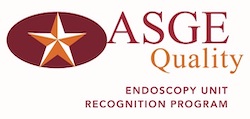
Successful applicants to the ASGE Endoscopy Unit Recognition Program submit a summary of a recently conducted quality improvement (QI) project as part of the application process. The QI project in the spotlight this month looks at polypectomy technique and risk of post polypectomy bleeding or colon perforation.
The purpose of the quality study was to monitor and track polypectomies if performed with cold snare, cold forceps, or hot snare. The study was performed to track all polypectomies performed at the center and identify the technique used if a post polypectomy bleed or colon perforation occurred. New data published demonstrates that “cold snare resection of polyps proves to have a more complete polyp resection as well as decreasing the risk of post polypectomy bleeding.” It has also been stated that “cold snare polypectomy reduces the chance of perforation as it is almost impossible to cut through the muscularis propria with a cold snare.” Incomplete resection of polyps may result in post polypectomy cancers. Cold forceps are associated with a high rate of incomplete resection even for diminutive polyps.
The center collected the data by tracking polypectomies performed during colonoscopies by using a tracking tool developed specifically for this study. It was the responsibility of the procedure/circulating nurses to utilize the tracking form. for the documentation of the method and number of polyps removed during the procedure. The center tracks and reports any/all post polypectomy bleeds as well as perforations, this information would be documented for the study on the tracking form as well as a QI reporting form.
The study was to determine the rate of occurrences for post polypectomy bleeds, colon perforations as well as complete polyp resection with each polypectomy removal technique. The study was to also determine the number of tubular adenomatous polyps vs. sessile serrated polyps removed by cold snare vs. cold forceps. The information/data for type of polyp and technique used for polypectomy will be abstracted from [endowriter] and GIQuIC. The study was to begin in March, however, due to the Covid 19 pandemic, the center was closed due to the guidance of the government. The facility reopened in May with a soft opening to ensure continued safety for all staff and patients. Data collected for the study began in August 2020 through the end of January 2021. The study revealed that from August 2020-January 2021 there were 3376 colonoscopies performed with a total of 1162 polypectomies performed. The breakdown revealed that polypectomy methods were: cold snare 556, hot snare 318, and cold forceps 288. The study did show that the most performed technique for polypectomy was cold snare. The results of this study reflect that performing polypectomy by cold snare has less risk of post polypectomy bleeds or colon perforation during the time the study was in progress. It was noted that on three occasions hemostasis clips were placed after a hot snare polypectomy as a preventative to decrease risk for post polypectomy bleed:
- The % of polyps <10mm removed with cold snare and cold forceps is 17%. Polyps <10mm removed via hot snare 44%.
- The % of tubular adenomatous polyps removed via cold snare is 16% and cold forceps removal is 35%.
- Removal of tubular adenomatous polyps with cold snare is 35% and serrated polyp removal via forceps is 18%.
The study did reveal there were no post polypectomy bleeds or colon perforations that occurred during the study. A higher percentage of polyps were removed via cold snare technique. One unexpected finding discovered during the study was an increase of polyps not retrieved during cold snare polypectomy. Some pathology reports identified vegetable material obtained or no tissue at all in formalin containers. It was determined that this would make a good study for 2021 to determine issues/technique or need for more education for the staff in verifying they obtained tissue and using proper techniques.
The results were presented to the Quality Committee on January 28, 2021. The committee confirmed the need to create a study for 2022 for collecting and sending the correct tissue for pathology. The results and new study for 2021 will be presented to the MEC Committee in April when the center holds its quarterly meeting. The results of this study will be presented to the Governing Board at the Biannual Meeting in July 2021. The center staff will be presented with the results of the study at the April staff meeting.
We hope sharing this project summary will be useful to you and your practice. Learn more about gaining honoree status in the ASGE Endoscopy Unit Recognition Program. Questions should be directed to eurp@asge.org.